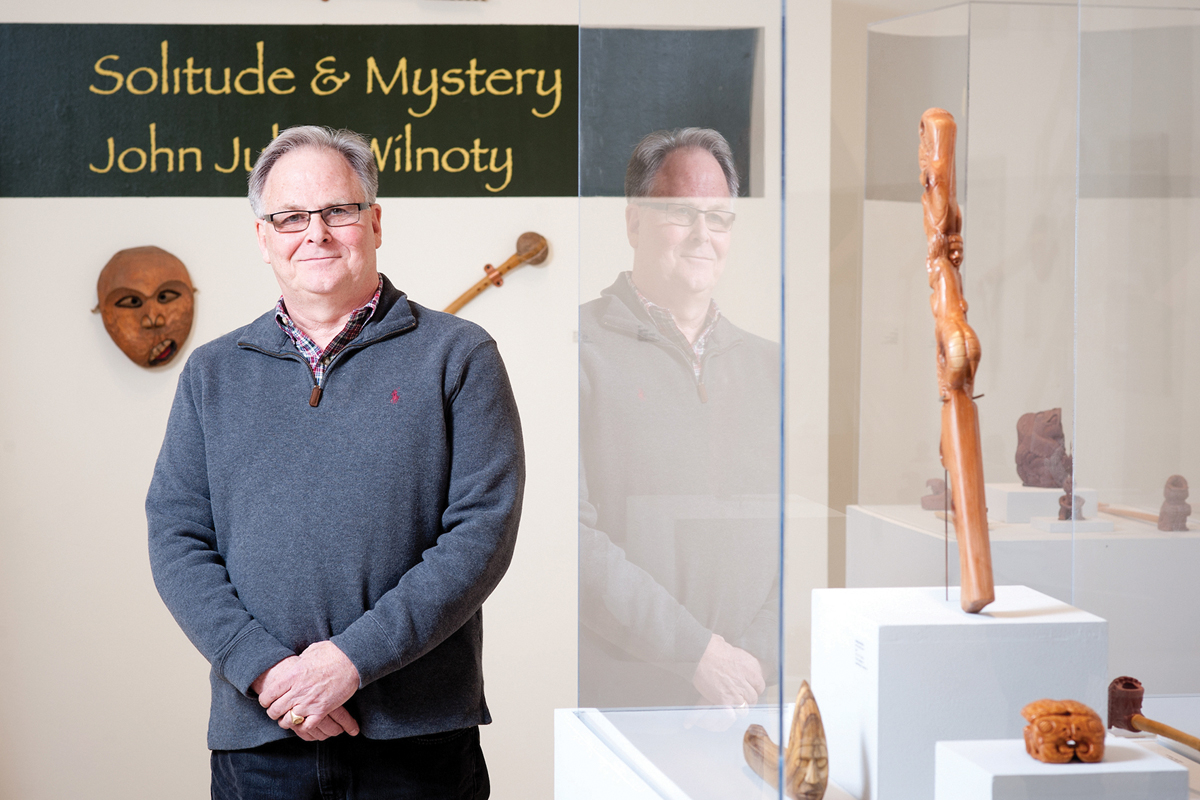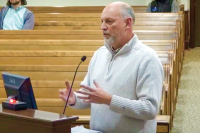Exhibition celebrates Lambert Wilson’s legacy
 Lambert Wilson stands at the opening of the 2016 “Solitude & Mystery” event at WCU’s Fine Art Museum. WCU Photo Services photo
Lambert Wilson stands at the opening of the 2016 “Solitude & Mystery” event at WCU’s Fine Art Museum. WCU Photo Services photo
In 1972, Lambert Wilson’s life changed forever.
He was still a teenager then, studying middle grade education as an undergraduate at Western Carolina University, when his introductory art history teacher Janie Leftwhich offered the class extra credit in exchange for visiting the Eagle Dancer sculpture by famed Cherokee artist John Julius Wilnoty .
Wilson took her up on it — and was blown away by what he saw. Every detail of the 27-inch piece communicated a sense of movement and majesty. Wilnoty had carved the single piece of cherry wood used to make it so that the tree’s rings suggested the muscles and underlying structure of the dancer’s body. The sight lit a spark inside the young man. At that moment, Wilson decided to start his own collection of Cherokee art.
“I think when he came to Western, not only did he find the Eagle Dancer, but he found the spirit too, of the Native Americans who settled this land,” said Jenny Holland, Wilson’s partner from 2006 until his death in 2022 . “I think that was part of his draw to WCU.”
Holland spoke to a crowd of more than 200 people who came to the WCU Fine Art Museum at Bardo Arts Center Aug. 30 for a reception marking an art exhibition showcasing Wilson’s art collecting legacy. Wilson, a Swain County native who spent three decades as an elementary school teacher and principal, served on the Swain County Board of Education and Southwestern Community College Board of Trustees and owned two motels and an art gallery in Cherokee, touched many lives during his 68 years on earth — and that impact was apparent in surveying those present Aug. 30. The crowd attending “Spark of the Eagle Dancer: The Collecting Legacy of Lambert Wilson” included educators, artists, tribal members and an array of community leaders.
“We knew him in different capacities, but I think we all knew him as a very passionate art collector,” said Carolyn Grosch, the museum’s curator of collections and exhibitions. “That was something he really dedicated 50 years of his life to.”
Related Items
In the 120-page exhibit book, professional curator and retired WCU Research Associate Professor Anna Fariello reflects on the first time she visited Wilson’s home.
“I can’t describe the shock of walking into his home and seeing every surface — every wall, every table, every shelf, literally everywhere — covered with Native American art,” she wrote. “I believe that Lambert Wilson’s collection is larger, more significant, than many at major institutions.”
The exhibition currently on display at WCU showcases more than 140 works of contemporary Native American art, spanning the gamut from baskets and pottery to photography and watercolor, in styles both traditional and modern. In her essay for the exhibition catalogue, Museum of the Cherokee Indian Director Shana Bushyhead Condill said Wilson’s collection was an important testament to the continued existence of Native people and Native culture.

Cherokee artist Joshua Adams believed Wilson liked his piece “Booger of Rebellion” because it was similar in scale to the original 27-inch Eagle Dancer carving. Tim Burleson photo
“The power, then, of contemporary Cherokee art is that it is impossible to relegate us to the past when looking at work from today,” she wrote. “Lambert, as curator of that exhibition, recognized that power and made a point of featuring artists working today. Importantly, also, is he drew that thread from our past to today, illustrating with pottery how our traditions have changed over time but are still influenced by the work of our ancestors.”
Taking over all three rooms of the exhibition space at WCU, the display celebrates not only the works themselves but also the relationship Wilson had with them and with their makers. In the display of “Chosen for Leadership” — a dramatic wooden mask standing 25 inches high and made of carved butternut wood, with a headdress of abalone shells, trade beads, rabbit fur and pheasant wings — EBCI artist Joshua Adams speaks of the affinity he had for Wilson and his mode of collecting.
“I always dreamed of doing Indian Market, and Lambert was always encouraging me to do that show,” reads a quote from Adams affixed to the display. “’Chosen for Leadership’ went on to win first place. I think Lambert showed up at four or five in the morning at my booth and said, ‘Hey I’ll buy that mask if no one buys it today.’ I had the chance to sell the mask a couple of times that day, and I didn’t because I wanted Lambert to have it. I just wanted to be part of his collection.”
“For Lambert, collecting was not simply about purchasing a work of art,” Grosch said during the reception. “And it wasn’t just about appreciating an object for its beauty, or its craftsmanship. Those were all important things to him, but I think for him, his impulse to collect really was an expression of his love for people and community.”
At first, Wilson focused his collection on Cherokee art. But in 2006, he met Holland, and together they expanded the collection to include artists from other tribes. They got a second home in Santa Fe, New Mexico, which became his “operational base” for Southwestern artists. Despite the heat, August was his favorite time to be in Santa Fe, because that’s when the annual Indian Art Market was held.
“He loved the art, but he loved the artists more,” Holland wrote in the exhibition catalogue.
Art exhibitions are often planned years in advance, but the display at WCU opened less than 10 months after Wilson’s untimely death in October 2022. That’s thanks to hard work and collaboration from Wilson’s friends and family, artists, Bardo Arts Center staff and others at WCU and in the Cherokee community, said Denise Drury Homewood, executive director of the Bardo Arts Center.
“I thank y’all for coming,” Wilson’s sister Linda Wike told the crowd. “Thank you for what Lambert meant to you. And I thank God he chose us girls to be his sisters. And that he was the best brother in the world. My wish for everybody here is that you have a brother like we do.”
See the exhibition
“Spark of the Eagle Dancer: The Collecting Legacy of Lambert Wilson” will remain on display through Friday, Dec. 8, at the WCU Fine Art Museum, located at 199 Centennial Drive on campus. The exhibit is free to visit and open 10 a.m. to 4 p.m. Tuesday through Friday and 10 a.m. to 7 p.m. Thursdays. For more information, call 828.277.ARTS or visit arts.wcu.edu/spark.









